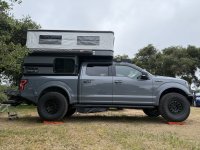montechie
Active member
I feel you, my wife and I are contemplating a larger build and test drove a 2500 Ram Rebel gasser yesterday and am scheduled to drive a F150 Tremor 5.0 402a this weekend. I currently have a Gladiator Rubicon, and have had Tacos, older F150s, etc.
Personally, the Rebel rode great, we took it down this narrow, frost-heaved road that's good at creating head toss and claustrophobia with steep shoulders. It tracked well and was easy to keep straight with little driver input, no head toss or tail shimmy. Surprisingly quiet engine, but that could be the active noise cancellation they have. Payload for this truck with the Rebel group 1 options was ~3000 lbs. Way more maneuverable than I expected, advantage of Ram in general, I think Ram's HD/SD trucks tend to have the shortest wheelbases. That hood and the wide mirrors still made it feel huge though. For a standard duty, I'm not convinced that rear coil linkages are a great idea if you are going to haul heavy loads frequently. Leaf springs ride rougher, but distribute load on the frame better IMO. Just a thought if you're wanting it long term. Personally I prefer the Ford 7.3 and feel more confident in it's longevity than the Hemi lifters. I do really like that ZF-8 transmission in the Ram over the Ford/Chevy 10-speed though. I also prefer the Ram 2500+ shock mount location over the F-250+ when it comes to the trails I enjoy.
On the F-150 side, there's also some good engine options, non-Tremor I'd say not to overlook the 2.7 eco. Sleeper reliability and designed differently than the 3.5. I talked to the local mechanics I work with and trust, and for new engines would choose the 5.0. My area eats lifters like candy. The 3.5 is reliable, and the 2.7 more so, but there's greater maintenance and overall cost to turbos if you keep your trucks a while, plus 5.0 vs 3.5 mpg isn't cut and dry, depends on how you use them and will stay "in-boost" vs out. The transmission is the main gotcha, but Ford just replaced a part for the main issue supposedly.
You really need to drive multiple, ideally rent them if you can. Decide what the end goal and need is, then walk back from there for the tool that addresses it.
Personally, the Rebel rode great, we took it down this narrow, frost-heaved road that's good at creating head toss and claustrophobia with steep shoulders. It tracked well and was easy to keep straight with little driver input, no head toss or tail shimmy. Surprisingly quiet engine, but that could be the active noise cancellation they have. Payload for this truck with the Rebel group 1 options was ~3000 lbs. Way more maneuverable than I expected, advantage of Ram in general, I think Ram's HD/SD trucks tend to have the shortest wheelbases. That hood and the wide mirrors still made it feel huge though. For a standard duty, I'm not convinced that rear coil linkages are a great idea if you are going to haul heavy loads frequently. Leaf springs ride rougher, but distribute load on the frame better IMO. Just a thought if you're wanting it long term. Personally I prefer the Ford 7.3 and feel more confident in it's longevity than the Hemi lifters. I do really like that ZF-8 transmission in the Ram over the Ford/Chevy 10-speed though. I also prefer the Ram 2500+ shock mount location over the F-250+ when it comes to the trails I enjoy.
On the F-150 side, there's also some good engine options, non-Tremor I'd say not to overlook the 2.7 eco. Sleeper reliability and designed differently than the 3.5. I talked to the local mechanics I work with and trust, and for new engines would choose the 5.0. My area eats lifters like candy. The 3.5 is reliable, and the 2.7 more so, but there's greater maintenance and overall cost to turbos if you keep your trucks a while, plus 5.0 vs 3.5 mpg isn't cut and dry, depends on how you use them and will stay "in-boost" vs out. The transmission is the main gotcha, but Ford just replaced a part for the main issue supposedly.
You really need to drive multiple, ideally rent them if you can. Decide what the end goal and need is, then walk back from there for the tool that addresses it.


